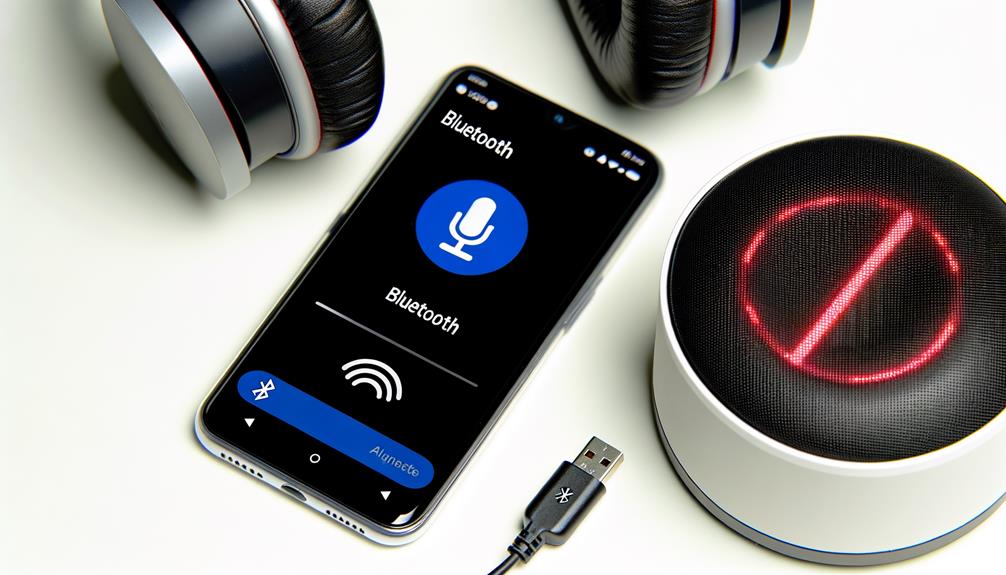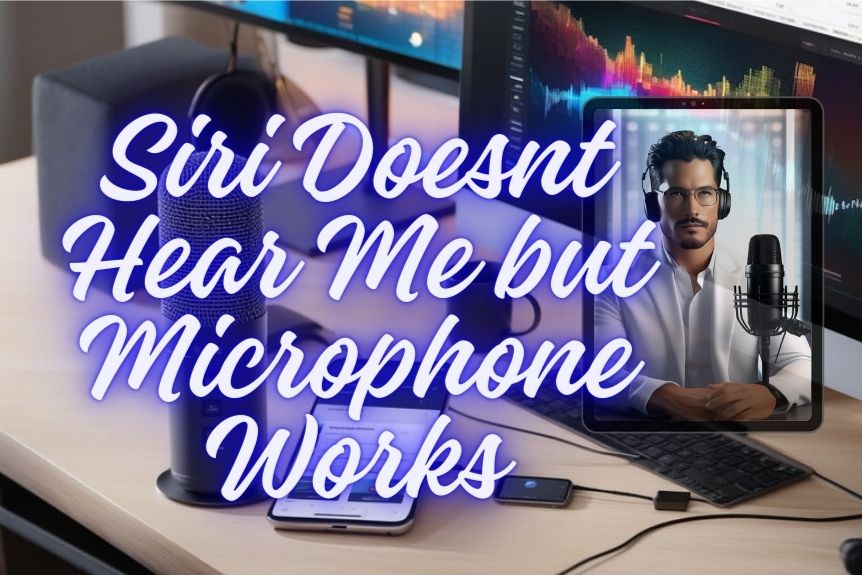If Siri doesn’t hear you, but your microphone works, it’s likely due to an issue with settings or possible interference, not a hardware problem. Check for Bluetooth or headphones connected to your iPhone that could be causing an issue. Turn on ‘Hey Siri‘ and adjust settings as needed to guarantee responses. Verify your iPhone’s microphone is clean and unobstructed. Try restarting your iPhone or updating your iOS. Remember, when multiple devices are connected, they could interfere with Siri’s responsiveness. Carefully checking any connected devices could resolve your problem. If you proceed further, it could enhance your understanding of how to perfect your Siri setup.
Disconnecting Headphones or Bluetooth Devices

If you’re experiencing difficulties with Siri not hearing you, it’s worth checking if any connected headphones or Bluetooth devices are causing interference. Apple’s Siri, integrated into your iPhone, is designed to respond when you say ‘Hey Siri’ or press the side button. But if Siri can’t hear you, it might be because a Bluetooth or earbud symbol is displayed in your Control Center, indicating a connected device that’s disrupting Siri’s functionality.
To fix this issue, access the Settings app on your iPhone. Choose Bluetooth and you’ll see a list of connected devices. Tap the ‘i’ button next to the device that may be causing the problem, and select ‘Disconnect’ or ‘Forget This Device’. This step ensures that Siri won’t listen through these devices, improving its responsiveness to your voice commands.
Enabling and Configuring Hey Siri
To make sure Siri responds promptly to your commands, you’ll need to enable and configure ‘Hey Siri’ on your iPhone. Enabling ‘Hey Siri’ gives your device the ability to hear and react to your voice commands, even when your iPhone is locked.
You can go about this process in three steps:
- Go to ‘Settings’ > ‘Siri & Search’, and make sure ‘Listen for Hey Siri’ is turned on. This will allow Siri to respond to your voice commands.
- To permit Siri to react even when your phone is locked, adjust the ‘Siri Responses’ settings. This ensures your voice commands are heard even if your device’s screen is off.
- Complete the setup process for voice recognition. This trains Siri to recognize your specific voice, enhancing the accuracy of responses.
If you notice that Siri fails to respond, a simple restart of your iPhone can resolve any software glitches that may be causing the issue. Remember, the key to seamless voice recognition is a well-configured ‘Hey Siri’ setup, allowing your device to hear your commands and respond accordingly.
Checking Microphone Functionality

While it’s crucial to have ‘Hey Siri’ properly configured, you’ll also need to make sure your microphone is working efficiently, as it’s the component that captures your voice commands. If ‘Hey Siri isn’t functioning’, don’t panic, your microphone might still be fine. Even if you ‘say hey Siri’ and receive no response, there are steps you can take to verify the microphone’s functionality.
Firstly, check the side of your device. Confirm nothing is obstructing the microphone grille. A clean microphone can make a world of difference. Use a microfiber cloth or a soft-bristle toothbrush to gently eliminate any debris. Avoid compressed air as it could harm the delicate parts inside.
If you discover that the microphone works for calls but you can’t use it for Siri, you may need to ‘inspect and re-enable’ Siri in your settings. ‘Press and hold‘ the home button to activate Siri manually. If ‘Siri not functioning‘ persists, it’s time to seek professional assistance. An Apple Store or authorized repair shop can diagnose and address any underlying issues. Remember, proper maintenance is crucial to ensure your ‘enable Siri’ command works every time.
Restarting and Updating Iphone
Often, you’ll find that a simple restart of your iPhone can resolve many software glitches, including those affecting Siri’s responsiveness. Here’s how you can Restart your iPhone:
- Press Side and Volume button until the power off slider appears.
- Slide to power off.
- After the device turns off, press and hold the Side button again until you see the Apple logo.
After a restart, it’s important to check the Hey Siri feature to make sure Siri responds to your voice commands correctly. If Siri still doesn’t recognize your voice, Apple Support recommends several troubleshooting steps.
Keeping your iPhone updated is an essential part of this process. An outdated iOS might prevent Siri from functioning properly. To set Siri to listen for your voice, follow the command that you see in the settings. The update might come with bug fixes that could resolve the issue.
Addressing Multiple Connected Devices

Your multiple connected devices can sometimes interfere with Siri’s ability to hear your commands, so it’s important to make sure Bluetooth is enabled on all of them. This can be a significant issue with Siri, especially if you’ve disabled Siri on one side and not the other.
You should check each device, be it your iPhone or iPad, and even your Mac, to confirm their Bluetooth status. This is vital to prevent a situation where multiple devices respond simultaneously to the ‘Hey Siri’ command, which can lead to confusion.
Here’s a simple table to help you troubleshoot:
| Action | Device | Result |
|---|---|---|
| Enable Bluetooth | iPhone/iPad | Siri hears commands |
| Check Bluetooth status | Mac | Identifies conflicts |
| Speak ‘Hey Siri’ | Closest device | Accurate response |
However, if ‘Hey Siri’ doesn’t hear you even after these steps, you might need to troubleshoot further. For instance, there might be connectivity issues between devices that are affecting your virtual assistant’s performance. So, always make sure your home button is working and your device’s microphone isn’t blocked or damaged.
